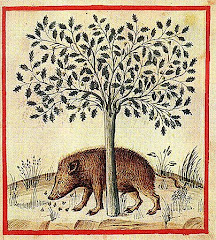
The red coloured chips are the raw material obtained from the heart of the trunk of the logwood. The stuff I've been using is 20 yr old pharmaceutical grade chippings that I was lucky enough to get from the pharmacognosy collection I've been cataloguing. It looks far less bitty and dusty than what I usually see being sold for dyeing so that it's characteristic green sheen is clearly visible in real life. Amazing stuff, it has a patina almost as you'd expect to see on a colourful beetle.
The black chips are how they look after use and the small piece of stocking is an indicator of just how little I used to obtain all the purple wool in the picture plus about the same quantity again in the same strong purple.
The first bath I did only used a small quantity of wool (I didn't expect the dye to go quite so far) and produced the bright violet visible on the un-spun fleece to the right.
Thereafter, I plonked in several loads more fleece and kept getting the medium purple visible at the back of the picture. The dye bath seemed to have absolutely no inclination to exhaust itself and eventually, exotic though purple is, I decided I'd had enough of it and didn't want to waste any more wool in an effort at clearing the dyebath.
Hoarder as I am, I put the dye pot full of purple liquid on a shelf until I could decide what to do with it. Logwood is expensive and I just couldn't bring myself to waste such a good bath.
Several months later I started noticing interesting solids bobbing up and down in the purple sludge that was still sitting there on the shelf. A prod with a long stick indicated it to be a new and rather slimy life form that was beginning to take on a shape of its own.
This discovery, combined with my need to do further experimentation before the Smithsonian festival finally led me to pull the pot off the shelf for another go. Interestingly, around the same time I read on a web site that leaving logwood water to oxygenate for a period of time can cause it to produce black instead of purple. Brilliant I thought, if 6 months isn't a decent period of time I don't know what is.
So I put my final 100g of fleece into the pot and boiled it up in high hopes of something bordering an exotic black. Sadly, I ended up with a rather blotchy and uninspiring colour I can only describe as browny-salmony-mauve. I didn't hold out much for a good result, but once carded and spun it it produced the paler mauve hank in the picture - a colour which has been growing on me ever since.
So I didn't get the black I had hoped for, but I'm satisfied with the rest and I now have enough purple wool to last me a life time.
Being my first attempt at dyeing in a kitchen setting, my methods for this lot have been a bit sporadic, but I can summarise it roughly as follows:
The wool used is mostly Hampshire (I think, it was someone's pet) and the occasional clump of white Jacob. All was pre-mordanted using Alum, but I have no idea what proportions I used for this batch.
My method was to boil up the logwood in my stainless steel dye pot for about 1 hour and I used the knotted stocking to prevent the chippings tangling up with the fleece.
The first lot of fleece, having been mordanted, was well wetted and warmed before being added to a gently simmering bath for around another hour. Thereafter I started throwing in whatever spare fleece I had to hand and, if I had some which wasn't mordanted, I chucked half the normal quantity of alum into the bath with it to simultaneously mordant it.
Once dyed, all fleeces were cooled and rinsed gently over a period of time and I used Ecover clothes washing liquid to clean out the excess dye. I then spent hours and hours carding and spinning purple on my wheel until I realised how overrated purple is and dropped it in favour of dyeing a few things yellow instead.
Incidentally, logwood will be going with me to the Smithsonian Folklife Festival for two reasons. Partly because it was definitely used by the Welsh dyeing industry of the 18th and 19th centuries and also because it's purple which is always a crowd pleaser.
Medicinally, logwood is not so impressive. The primary blue pigment of the heartwood, haematoxylin, is used in medical staining and also oxidises to form haematin - something I thought was a purely animal substances formed by the breakdown of haemoglobin. In fact, it seems haematin has been used to treat acute intermittent porphyria, but I bet that's from animal sources too.
Still, it's interesting that the contents of a purple tree can be even vaguely connected to a disease that sometimes causes purple urine - is there an inkling of the Doctrine of Signatures in here somewhere? Disappointingly, one source confirms for me that the haematin of logwood and the haematin of blood are not the same which I find just a little annoying. Once again I wish chemical names could be classified and systematised as logically as botanical names can.
Medicinally, logwood is not so impressive. The primary blue pigment of the heartwood, haematoxylin, is used in medical staining and also oxidises to form haematin - something I thought was a purely animal substances formed by the breakdown of haemoglobin. In fact, it seems haematin has been used to treat acute intermittent porphyria, but I bet that's from animal sources too.
Still, it's interesting that the contents of a purple tree can be even vaguely connected to a disease that sometimes causes purple urine - is there an inkling of the Doctrine of Signatures in here somewhere? Disappointingly, one source confirms for me that the haematin of logwood and the haematin of blood are not the same which I find just a little annoying. Once again I wish chemical names could be classified and systematised as logically as botanical names can.












2 comments:
This look amazing, Kristina - wish I had the time and the wherewithall to try dyeing! Can we order a purple hat to use up all your purple wool??
It's certainly possible. I have a relative who's just come of age for a purple hat so I had been thinking about such uses. Not sure about the quality of some of the wool though. In my effort to use up the dye as quickly as possible, I fear some of the wool may only be suitable for a purple rug (a lumpy one) - it's certainly a pain to try and card.
Post a Comment